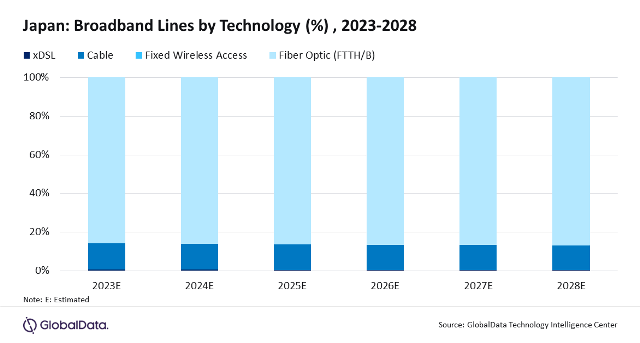Japan’s fixed service revenue is projected to experience steady growth, with a compound annual growth rate (CAGR) of 1.3 percent, reaching $31 billion by 2028, according to the latest report from GlobalData. This growth is primarily attributed to the robust performance of the fixed broadband segment.
 The Japan Fixed Communications Forecast for Q3-2023, released by GlobalData, reveals several key trends in the Japanese telecommunications market. Fixed voice service revenue is expected to decline at a -0.8 percent CAGR during the forecast period. This decline can be attributed to a significant shift among consumers from traditional telephony services to mobile and over-the-top (OTT) communication services. Additionally, the average revenue per user (ARPU) for voice services is anticipated to decrease.
The Japan Fixed Communications Forecast for Q3-2023, released by GlobalData, reveals several key trends in the Japanese telecommunications market. Fixed voice service revenue is expected to decline at a -0.8 percent CAGR during the forecast period. This decline can be attributed to a significant shift among consumers from traditional telephony services to mobile and over-the-top (OTT) communication services. Additionally, the average revenue per user (ARPU) for voice services is anticipated to decrease.
In contrast, fixed broadband service revenue is set to experience robust growth, with a CAGR of 2.5 percent between 2023 and 2028. This growth is driven by an increasing number of fixed broadband subscriptions, especially to fiber broadband services.
Fiber optic lines are expected to comprise 87 percent of the total broadband lines by 2028. This surge is underpinned by the growing demand for high-speed broadband connectivity, the government and operators’ emphasis on enhancing and expanding fiber-optic networks, and the rising availability of competitively priced fiber broadband plans. Consequently, fiber optic service revenue is projected to grow at a CAGR of 2.9 percent between 2023 and 2028.
NTT (Nippon Telegraph and Telephone Corporation) is poised to maintain its leading position in both the fixed voice and fixed broadband segments through 2028. In the fixed voice segment, NTT’s strong presence is supported by its position in both the circuit-switched and VoIP segments.
In the fixed broadband segment, NTT offers convenient installment payment options for initial setup fees and customized plans for customers residing in various types of households, including single-unit homes or multi-unit apartments through its regional units, NTT East and NTT West.
As Japan’s telecommunications landscape continues to evolve, this forecast underscores the growing importance of high-speed broadband and the changing preferences of consumers in the country, with NTT playing a pivotal role in this transformative process, Hrushikesh Mahananda, a Telecom Research Analyst at GlobalData, said.
